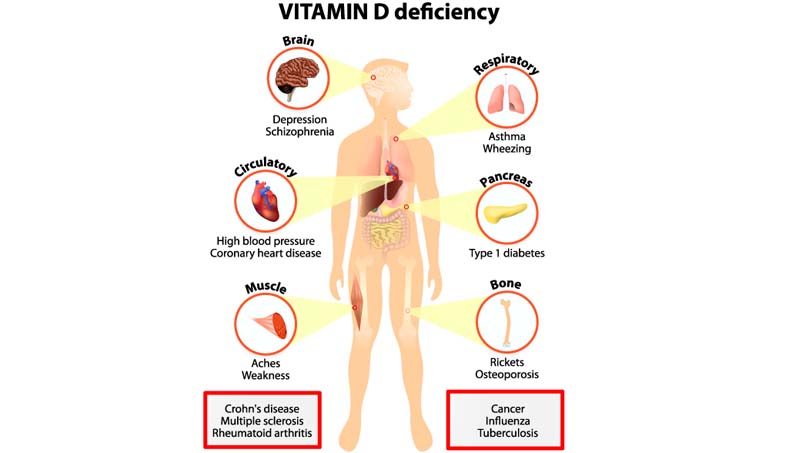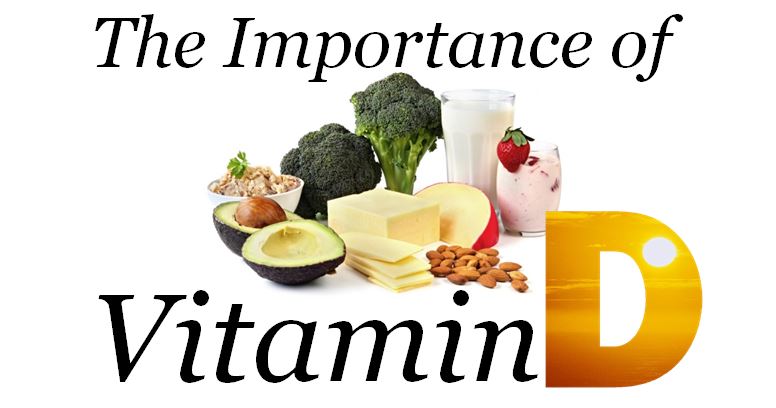
Vitamin D fat-soluble secosteroids. Its job is to absorb calcium from the intestines. It also dissolves iron, magnesium, and phosphorus, which increases immunity and improves physical condition.
If you see any symptoms, you will understand that there is a lack of vitamin D in the body. Muscle weakness: Lack of vitamin D increases the weakness of the muscles. Muscles grow and problems like tremors are created.
- What Is Vitamin D Deficiency?
- Why Is Vitamin D Important?
- Causes of Vitamin D Deficiency:
- 14 Signs And Symptoms Of Vitamin D Deficiency:
- Pain And Suffering:
- Stagnant Growth And Developmental Delays:
- Convulsions:
- Restlessness, Laziness:
- Tetany:
- Muscle weakness:
- Cardiomyopathy:
- Rickets:
- Weak Bone:
- Bad Growth:
- Bone Swelling And Abnormal Curvature:
- Frequent Lower Respiratory Infections:
- Delayed Teething in Children:
- Delayed Anterior-Fontanel Closure:
- Source of Vitamin D To Prevent Deficiency:
Some food items that are rich in vitamin D consist of fish, milk, egg white, cheese, liver of beef, salmon, citrus fruits such as lemon, oranges, etc. The omega 3 in fish is extremely useful to ease the vitamin D deficiencies and intensify the protection of your body.
Let’s now know in detail about symptoms, sources, causes, and prevention of Vitamin D deficiency…
What Is Vitamin D Deficiency?
 As the name implies, a low level of vitamin D in the body is termed as vitamin D deficiency. So, what is vitamin D deficiency? In fact, the level of vitamin D in the blood serum is measured in the form of 25-hydroxy-vitamin D (calcidiol) which determines it.
As the name implies, a low level of vitamin D in the body is termed as vitamin D deficiency. So, what is vitamin D deficiency? In fact, the level of vitamin D in the blood serum is measured in the form of 25-hydroxy-vitamin D (calcidiol) which determines it.
A deficit is considered to be below 25 nml / L and insufficiency is considered to be below 25-50 nml / L When the level is above 50 nml / L, there is evidence of benefit in bone, muscle, immunity, and insulin secretion.
Why Is Vitamin D Important?
 Nutrition is very complex and requires a perfect balance for its optimal benefits. The body can fill a small deficit and many times, even an additional deficit, but only in small amounts, especially in the case of growing children. It is vitamin D that will enable your baby to play around without difficulty and with good strength and power.
Nutrition is very complex and requires a perfect balance for its optimal benefits. The body can fill a small deficit and many times, even an additional deficit, but only in small amounts, especially in the case of growing children. It is vitamin D that will enable your baby to play around without difficulty and with good strength and power.
Bone needs calcium and phosphorus to carry energy, war and tears, and weight. Vitamin D ensures that the bones are not deprived of either. Vitamin D enables the intestinal lining to absorb calcium from food, process it in the blood, and store it in the bones.
Calcium is important for the functioning of every cell in the body. It is needed to open the door of the cell to get molecules to produce energy and to supply energy to your muscles to start the contraction of each muscle fiber. It helps us understand why vitamin D is important for children and how its deficiency will affect them.
Causes of Vitamin D Deficiency:
 The most important cause of vitamin D deficiency is limited or no exposure to sunlight. However, even in countries like India where there is plenty of sunlight, it is still quite common. Why is this? To understand other factors, you need to understand how vitamin D is produced, processed, stored, and used by the body.
The most important cause of vitamin D deficiency is limited or no exposure to sunlight. However, even in countries like India where there is plenty of sunlight, it is still quite common. Why is this? To understand other factors, you need to understand how vitamin D is produced, processed, stored, and used by the body.
Upon exposure to UV B in the sun’s rays, the epidermis (the upper layer of the skin) converts cholesterol into provitamin D3, which enters the bloodstream and is transferred to the liver. Vitamin D also comes from foods/supplements, absorbed from the stomach, and sent to the liver. The liver converts it to a more potent form.
It is then transferred to the kidneys where it is converted to calcitriol – this form is actively ready to work. So, now it is easier to understand that vitamin D deficiency can be created in the following situations even after being in good sunlight.
Decreased Acceptability Of Vitamins In Food: Strict vegan diet, dietary habits (low intake of vitamin-rich foods), elimination diet (milk allergies), etc.
Increasing Depletion: Drugs such as anticonvulsants, anti-tuberculosis, steroids that may interfere with the process of vitamin D production or absorption.
Low vitamin D synthesis: Dark skin, ultraviolet rays, sunscreen lotions and clothing, latitude (UVB is not very effective in sunlight in the UK for example), seasons, air pollution, limiting the time spent outside of children and adolescents Vitamin D synthesis is reduced due to air-conditioned housing, colored glasses, light-sensitive skin conditions, etc.
Decreased Maternal Vitamin D Storage: Exclusive breastfeeding where the mother does not store enough vitamin D in her body to nurture the child.
Defective synthesis: Chronic liver disease, kidney disease, etc. can lead to improper functioning of the organs required for the production and absorption of vitamin D.
14 Signs And Symptoms Of Vitamin D Deficiency:

Pain And Suffering:
They are frequent pains in the hands, feet, body in proportion to the child’s physical development milestone which is not accurate.
Stagnant Growth And Developmental Delays:
Even if there are no known health problems and even after eating well, your baby may not be identified according to height, weight, and other developmental milestones.
Convulsions:
One of the causes of convulsions in children is vitamin D deficiency and requires immediate treatment.
Restlessness, Laziness:
The child is no longer restless and attentive and most of the time is abnormally whining and annoyed for no reason.
Tetany:
This is a stage of hypocalcemia which refers to low levels of calcium in the blood. There are many causes of calcium deficiency such as poor diet, poor absorption, vitamin D deficiency, abnormal parathyroid hormone secretion, kidney abnormalities, sudden episodes of shortness of breath, odor, muscle weakness, and muscle cramps.
Muscle weakness:
Muscle weakness is due to delay in walking, difficulty in climbing stairs, etc.
Cardiomyopathy:
Low vitamin D affects all the muscles in the body so the heart muscles also become weak.
Rickets:
Injured knee, growing deformity of the foot, bent gate, abnormally curved knee deformity, swelling of the wrist and costochondral junction, prolonged bone pain (> 3 months duration).
Weak Bone:
Lack of vitamin D indicates that calcium is not absorbed properly. Minor injuries can easily lead to fractures.
Bad Growth:
Despite a healthy diet, active lifestyle, and any previous medical problems, bad growth may not indicate vitamin D deficiency.
Bone Swelling And Abnormal Curvature:
X-ray of the wrist or ankle or chest causes bone swelling and abnormal curvature of long bones due to low calcium levels. low plasma calcium or phosphate levels, raising alkaline phosphate.
Frequent Lower Respiratory Infections:
Vitamin D plays an important role in the development of pulmonary function and immunity and frequent infections can be caused by the same deficiency.
Delayed Teething in Children:
Like other milestones, lack of adequate calcium can lead to delayed or brittle teeth.
Delayed Anterior-Fontanel Closure:
The anterior-fontanel is a diamond-shaped open portion at the front of the head. It is a gap in the skull that gradually closes at the age of 18-24 months. Due to the functionality of the disabled bone, it will be delayed.
Source of Vitamin D To Prevent Deficiency:
 The sun’s ultraviolet rays are one of the best sources of vitamin D. When the sun is bright, the ultraviolet rays reach the earth. However, glass, thick clouds, smoke, and sunscreen block this ray.
The sun’s ultraviolet rays are one of the best sources of vitamin D. When the sun is bright, the ultraviolet rays reach the earth. However, glass, thick clouds, smoke, and sunscreen block this ray.
If you can take vitamin D supplements in prescribed doses, your body can make up for the deficiency of vitamin-D. If you can sit under sunlight for 10 minutes every day, the deficiency of vitamin-D will also be prevented.
However, you can also get Vitamin D from some food items. The list of Vitamin D rich food items is as follows: Oily fish such as cod or shark liver oil and the livers of other animals are also rich in vitamin D.
In addition, milk, egg yolks, butter, and fatty foods contain vitamin D. Animals that graze in the field and get plenty of sunlight to have higher levels of vitamin D in their milk, eggs, and liver.
Vitamin D Rich Foods:
- Oily fish
- Paneer
- Mushrooms
- Egg yolk
- Cheese
- Milk
NOTE: The main source of vitamin-D is sunlight. Basically, 80 percent of vitamin-D is dependent on sunlight.